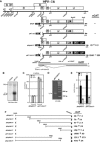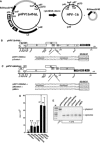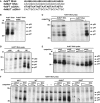Suppression of HPV-16 late L1 5'-splice site SD3632 by binding of hnRNP D proteins and hnRNP A2/B1 to upstream AUAGUA RNA motifs
- PMID: 24013563
- PMCID: PMC3905901
- DOI: 10.1093/nar/gkt803
Suppression of HPV-16 late L1 5'-splice site SD3632 by binding of hnRNP D proteins and hnRNP A2/B1 to upstream AUAGUA RNA motifs
Abstract
Human papillomavirus type 16 (HPV-16) 5'-splice site SD3632 is used exclusively to produce late L1 mRNAs. We identified a 34-nt splicing inhibitory element located immediately upstream of HPV-16 late 5'-splice site SD3632. Two AUAGUA motifs located in these 34 nt inhibited SD3632. Two nucleotide substitutions in each of the HPV-16 specific AUAGUA motifs alleviated splicing inhibition and induced late L1 mRNA production from episomal forms of the HPV-16 genome in primary human keratinocytes. The AUAGUA motifs bind specifically not only to the heterogeneous nuclear RNP (hnRNP) D family of RNA-binding proteins including hnRNP D/AUF, hnRNP DL and hnRNP AB but also to hnRNP A2/B1. Knock-down of these proteins induced HPV-16 late L1 mRNA expression, and overexpression of hnRNP A2/B1, hnRNP AB, hnRNP DL and the two hnRNP D isoforms hnRNP D37 and hnRNP D40 further suppressed L1 mRNA expression. This inhibition may allow HPV-16 to hide from the immune system and establish long-term persistent infections with enhanced risk at progressing to cancer. There is an inverse correlation between expression of hnRNP D proteins and hnRNP A2/B1 and HPV-16 L1 production in the cervical epithelium, as well as in cervical cancer, supporting the conclusion that hnRNP D proteins and A2/B1 inhibit HPV-16 L1 mRNA production.
Figures









Similar articles
-
Polypyrimidine tract binding protein induces human papillomavirus type 16 late gene expression by interfering with splicing inhibitory elements at the major late 5' splice site, SD3632.J Virol. 2008 Apr;82(7):3665-78. doi: 10.1128/JVI.02140-07. Epub 2008 Jan 23. J Virol. 2008. PMID: 18216120 Free PMC article.
-
Identification of a 17-nucleotide splicing enhancer in HPV-16 L1 that counteracts the effect of multiple hnRNP A1-binding splicing silencers.Virology. 2007 Dec 20;369(2):351-63. doi: 10.1016/j.virol.2007.08.002. Epub 2007 Sep 14. Virology. 2007. PMID: 17869320
-
Heterogeneous Nuclear Ribonucleoprotein C Proteins Interact with the Human Papillomavirus Type 16 (HPV16) Early 3'-Untranslated Region and Alleviate Suppression of HPV16 Late L1 mRNA Splicing.J Biol Chem. 2015 May 22;290(21):13354-71. doi: 10.1074/jbc.M115.638098. Epub 2015 Apr 15. J Biol Chem. 2015. PMID: 25878250 Free PMC article.
-
HPV-16 RNA processing.Front Biosci. 2008 May 1;13:5880-91. doi: 10.2741/3123. Front Biosci. 2008. PMID: 18508629 Review.
-
Papillomavirus transcripts and posttranscriptional regulation.Virology. 2013 Oct;445(1-2):187-96. doi: 10.1016/j.virol.2013.04.034. Epub 2013 May 23. Virology. 2013. PMID: 23706315 Review.
Cited by
-
HPV and RNA Binding Proteins: What We Know and What Remains to Be Discovered.Viruses. 2024 May 15;16(5):783. doi: 10.3390/v16050783. Viruses. 2024. PMID: 38793664 Free PMC article. Review.
-
A novel HPV16 splicing enhancer critical for viral oncogene expression and cell immortalization.Nucleic Acids Res. 2024 Jan 11;52(1):316-336. doi: 10.1093/nar/gkad1099. Nucleic Acids Res. 2024. PMID: 37994701 Free PMC article.
-
HnRNP D activates production of HPV16 E1 and E6 mRNAs by promoting intron retention.Nucleic Acids Res. 2022 Mar 21;50(5):2782-2806. doi: 10.1093/nar/gkac132. Nucleic Acids Res. 2022. PMID: 35234917 Free PMC article.
-
Splicing and Polyadenylation of Human Papillomavirus Type 16 mRNAs.Int J Mol Sci. 2017 Feb 9;18(2):366. doi: 10.3390/ijms18020366. Int J Mol Sci. 2017. PMID: 28208770 Free PMC article. Review.
-
hnRNP L controls HPV16 RNA polyadenylation and splicing in an Akt kinase-dependent manner.Nucleic Acids Res. 2017 Sep 19;45(16):9654-9678. doi: 10.1093/nar/gkx606. Nucleic Acids Res. 2017. PMID: 28934469 Free PMC article.
References
-
- zur Hausen H. Papillomaviruses and cancer: from basic studies to clinical application. Nat. Rev. Cancer. 2002;2:342–350. - PubMed
-
- Walboomers JM, Jacobs MV, Manos MM, Bosch FX, Kummer JA, Shah KV, Snijders PJ, Peto J, Meijer CJ, Munoz N. Human papillomavirus is a necessary cause of invasive cervical cancer worldwide. J. Pathol. 1999;189:12–19. - PubMed
-
- Parkin DM, Bray FI, Devesa SS. Cancer burden in the year 2000. The global picture. Eur. J. Cancer. 2001;37(Suppl. 8):24–66. - PubMed
-
- Bouvard V, Baan R, Straif K, Grosse Y, Secretan B, El Ghissassi F, Benbrahim-Tallaa L, Guha N, Freeman C, Galichet L, et al. A review of human carcinogens—part B: biological agents. Lancet Oncol. 2009;10:321–322. - PubMed
Publication types
MeSH terms
Substances
LinkOut - more resources
Full Text Sources
Other Literature Sources
Molecular Biology Databases
Research Materials

